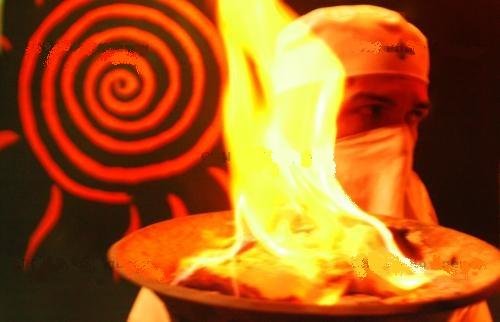Contenus
ToggleIn short
Sadeh (سده ), est une fête Iranian qui remonte au premier empire Persian, l’empire achéménide. Sadeh célèbre 50 jours avant Norouz. Sadeh en persan signifie « cent » et se réfère à cent jours et nuits restants au début du printemps. Sadeh est un festival de mi-hiver qui a été célébré avec grandeur et magnificence dans l’ancienne Perse. C’était une fête pour honorer le feu et vaincre les forces des ténèbres, du gel et du froid.

Sadeh, les 100 jours et nuits
THE legends racontent que le roi Hushang, le 2e roi de la dynastie mythologique des Pishdadiens (Pishdad signifie donner la Loi), a établi la tradition Sadeh. On dit qu’une fois Hushang escaladait une montagne lorsqu’il vit un serpent et voulut le frapper avec une pierre. Quand il a jeté la pierre, elle est tombée sur une autre pierre et comme il s’agissait de pierres de silex, le feu s’est déclaré et le serpent s’est échappé. De cette façon, il a découvert comment allumer un feu. Hushang se réjouit et loua Dieu qui lui révéla le secret pour allumer un feu. Puis il annonça : « C’est une lumière de Dieu. Il faut donc l’admirer.
Selon les croyances religieuses, Jashn-e Sadeh rappelle l’importance de la lumière, du feu et de l’énergie ; la lumière qui vient de Dieu se trouve dans le cœur de ses créatures.
Dans les temps anciens, Jashn-e Sadeh était célébré en allumant du feu. Pour les zoroastriens, la principale préparation de Sadeh était et est encore dans certaines régions la collecte de bois la veille de la fête. Des adolescents accompagnés de quelques hommes adultes se rendaient dans les montagnes locales pour ramasser des camelthorn, un arbuste du désert commun en Iran.
L’occasion ressemble à un rituel de passage à l’âge adulte, une étape notable pour les garçons en route vers la virilité. Les garçons emportaient les camelthorn dans les temples de leurs villes. Si c’était la première fois qu’ils le faisaient, à leur retour, une fête avait lieu à la maison en présence d’amis et de familles.
Dans les temps anciens, les feux étaient toujours allumés près de l’eau et des temples. Le feu était à l’origine destiné à aider à la renaissance du soleil et à ramener la chaleur et la lumière de l’été. Il était également destiné à chasser les démons du gel et du froid, qui transformaient l’eau en glace et pouvaient ainsi tuer les racines des plantes.
Le feu a été allumé toute la nuit. Le lendemain, les femmes allaient au feu le matin, chacune rapportant une petite partie du feu chez elles pour faire un nouveau feu rougeoyant à partir du « feu béni » du temple. Il s’agit de répandre la bénédiction du feu de Sadeh à tous les ménages du quartier. Tout ce qui restait du feu serait ramené au sanctuaire pour être placé dans un récipient et conservé au temple jusqu’à l’année suivante. De cette façon, le feu est maintenu allumé toute l’année. Le « feu éternel » symbolise aussi l’amour de la patrie qui est toujours vivant comme un feu ardent dans le cœur des gens.
Les festivités devaient normalement durer trois jours. Les soirées sont consacrées à manger et à donner des aliments en guise de dons, des aliments préparés à partir d’agneaux abattus et distribués aux pauvres.
Le rapport le plus élaboré de la célébration de Sadeh après la conquête musulmane de la Perse au 7ème siècle après JC vient du 10ème siècle après JC sous le règne de Mardavij de la dynastie Ziyarid, le souverain d’Ispahan. La dynastie Ziyarid a fait de son mieux pour maintenir les traditions Persian. Des feux de joie ont été installés des deux côtés de la rivière Zayandeh pour rappeler la coutume de Sadeh.
Les feux étaient conservés dans des supports métalliques spécialement construits. Des centaines d’oiseaux ont été lâchés pendant que le feu d’artifice illuminait le ciel. Il y avait des feux d’artifice, de la danse et de la musique avec de somptueux festins d’agneau rôti, de bœuf, de poulet et d’autres délices.
Aujourd’hui, la cérémonie est célébrée un peu comme dans les temps anciens dans certaines villes iraniennes comme Kerman et Yazd. Jashn e Sadeh est également célébré chaque année dans les jardins de Kushke Varjavand à Karaj (un canton de la province de Téhéran) avec la présence de zoroastriens persans et d’autres personnes intéressées par les cérémonies traditionnelles persanes. Parfois, les feux ne sont pas allumés à l’extérieur et toutes les activités se déroulent à l’intérieur des temples zoroastriens.
Les activités de cueillette de camelthorn ont presque été arrêtées bien qu’il y ait des efforts pour préserver la tradition. Cependant, la majeure partie des Iraniens/Perses se familiarisent avec l’occasion et il y a des rassemblements et des célébrations même à l’extérieur du pays le 30 janvier chaque année. Les gens se rassembleront et prieront, puis ils se tiendront par la main, formeront un cercle et danseront autour du feu.
Chaque année, le 30 janvier, les zoroastriens en Iran et dans d’autres pays célèbrent la fête religieuse de Jashn-e Sadeh en brûlant du bois dans un espace ouvert pour signifier l’arrivée du printemps et comme signe symbolique de l’éternel combat contre le mal.
Social networks
Today, Zoroastrians celebrate the religious festival of Jashn-e Sadeh by burning wood in an open space to signify the arrival of spring and as a symbolic sign of the eternal fight against evil. #mythology #myth #legend #30January #calendar #sadeh #zoroaster
Picture
